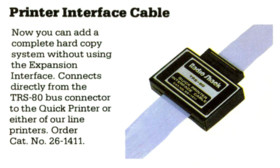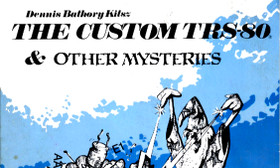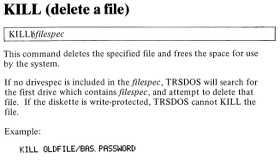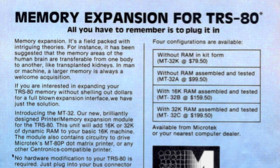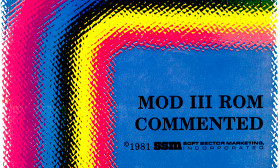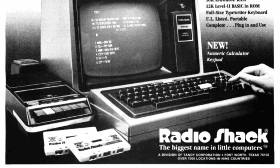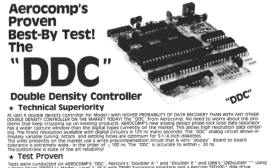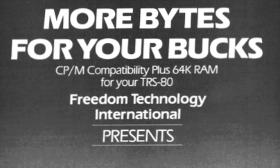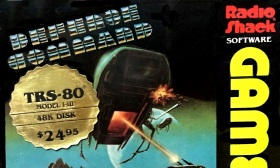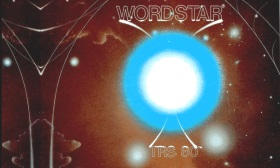One of the limitations of the cassette-based TRS-80 Model I was that it had no printer port. There were many cassette programs designed to use a printer, such as Electric Pencil and Scripsit, but no simple way to add one. Only a few Radio Shack printers were designed to connect to a cassette-based Model I directly.
The usual approach to adding a printer was to buy a Radio Shack Expansion Interface. In addition to providing extra memory and a floppy disk controller, the Expansion Interface also added a printer port. But a fully equipped Expansion Interface cost more than a Model I itself, and a unit with no memory still cost $299.00. Another option was a lighter-weight third-party Expansion Interface, such as the Microtek MT-32 or Exatron MM+. But this was still overkill if all you wanted was a printer.
(Read more...)
The Custom TRS-80 and Other Mysteries is one of the best remembered TRS-80 books. It was written by Dennis Báthory-Kitsz and published by IJG, Inc (also known as the International Jewelry Guild). The first printing sold out in less than a month and the book ended up selling 50,000 copies around the world in three printings. The Custom TRS-80 and Other Mysteries (which was volume 3 in IJG’s TRS-80 Information Series) offers an interesting and entertaining look at the hardware and software inside the TRS-80 Model I, the custom TRS-80 of the title.
Dennis Báthory-Kitsz was well known for his TRS-80 writing, including his articles in The Alternate Source and his 80 Applications column in 80 Microcomputing. (Some of the information in The Custom TRS-80 and Other Mysteries had previously appeared in his Alternate Source articles.)
(Read more...)
The KILL command was probably the most unusually named command in the TRSDOS disk operating systems for TRS-80 computers. KILL was used to delete a file, for example: KILL FILENAME/EXT.
The KILL command was supported by versions of TRSDOS for the Model I, Model III, and Model II, as well as the BASIC interpreters for all those machines plus the Model 4, Color Computer, the Model 100, Model 102, Model 200, and the Model 2000. In addition, all of the TRSDOS-compatible TRS-80 Model I/III operating systems (NEWDOS, MULTIDOS, DOSPLUS, and LDOS) also implemented the KILL command.
The use of KILL as a command was somewhat controversial and many people objected to the connotation. Here’s what Josef Friedman said about KILL in his article “Thou Shalt Not Kill” in the November 1984 issue of 80 Micro:
(Read more...)
By itself, the TRS-80 Model I was capable of only limited expansion. In order to add memory beyond 16K and support floppy disk drives, Radio Shack sold an external device they called an Expansion Interface.
The Expansion Interface could expand memory to 48K, add a parallel printer port, and add a disk controller for connecting floppy disk drives. But an Expansion Interface with 32K of memory cost $597.00, almost $100 more than a 4K Model I. What if a Model I owner didn’t want (or couldn’t afford) disk drives but still wanted to add memory and a printer port?
The MT-32 from Microtek, Inc. of San Diego, California used a different approach from the Radio Shack Expansion Interface. The MT-32, introduced in mid-1980, offered only two features: the ability to add 32K of RAM (for a total of 48K) and a parallel printer port.
(Read more...)
There were many books written that described and in some cases disassembled the TRS-80 Model I BASIC ROM. A few of the more famous examples were Microsoft BASIC Decoded and Other Mysteries from IJG, Inc., The B00K from Insiders Software Consultants, Pathways Through the ROM from SoftSide Publications, and Level II ROMs from Tab Books. But there were far fewer books serving the same purpose for the TRS-80 Model III BASIC ROM.
One of the best sources of information about the Model III ROM was TRS‑80 ROM Routines Documented by Jack Decker, which was published in 1983. But probably the best known was MOD III ROM Commented from Soft Sector Marketing. MOD III ROM Commented was published in 1981 with two printings. It contains a very detailed disassembly of the Model III BASIC ROM. As the book cover promised: “Not a rehash of old information, but an explanation of ROMS in the latest machine from Tandy.”
(Read more...)
When the TRS-80 Model I was introduced on August 3, 1977, it came with Level I BASIC, a 4K BASIC interpreter, in ROM. Level I BASIC was created by Steve Leininger, the designer of the TRS-80, who based it on the public domain “Palo Alto Tiny BASIC” that Dr. Li-Chen Wang wrote in 1976.
But Radio Shack’s plan was always to upgrade to a more advanced Model I BASIC later. The very first TRS-80 brochure said that “planned expansion includes an extended Radio Shack Level II BASIC.” It was mentioned again in the first issue of the TRS-80 Microcomputer News (then known as the Radio Shack Microcomputer Newsletter) in 1977:
A Level II BASIC is now being developed. This will be a 12K BASIC with every feature you ever imagined – PEEK and POKE, PRINT USING, transcendental functions, advanced string handling, etc. It should be available on ROM soon.
(Read more...)
The Aerocomp DDC was a popular double-density add-on for the TRS-80 Model I. It was introduced in 1981 by Aerocomp Inc. of Dallas, Texas, a company founded by John Lancione. Aerocomp was one of the longest lasting TRS-80 companies and the Aerocomp DDC was sold for almost a decade.
When it was introduced, the Aerocomp DDC cost $149.95. This was $20 cheaper than its primary competitor, the Percom Doubler II. Aerocomp also sold the Aerocomp DDC bundled with a choice of operating systems: DOSPLUS 3.3 for $189.95 and with LDOS for $239.95.
The Percom Doubler was the original Model I doubler and the Aerocomp DDC was designed to be software compatible with it. The Aerocomp DDC (like the Percom Doubler) used double-density encoding to increase disk capacity on a 40-track single-sided disk from 100K to 180K
(Read more...)
The Freedom Option was a CP/M add-on for the TRS-80 Model I, Model III, and compatibles. It was introduced in early 1980 by Field Engineering Consultants (better known as FEC) of Woburn, Massachusetts.
Originally, FEC sold two Freedom boards, both for a 48K Model I with disk drives:
- The Freedom Option allowed CP/M (or the included T8/OS) to run by disabling the Model I ROM. It cost $245.00.
- The Memory Expansion Option had the same features as the Freedom Option, but also added an extra 16K of RAM. This provided a full 64K of RAM for the Model I, meaning that 57K was available for programs when running T8/OS. It cost $295.00.
Both the Freedom Option and the Memory Expansion Options were fairly small boards that installed inside the Model I case. As one advertisement stated they were “easy to install plug-in boards; no wires or traces to cut; no soldering.”
(Read more...)
Most people considered the Big Five Software games to be the finest games ever written for the TRS-80 Model I and III. They were sold directly through Big Five Software and were resold by many other companies.
Radio Shack also sold Big Five Software games in two collections compiled by Cogito Software. Games Pack Two and Games Pack Three first appeared in the 1984 Radio Shack catalog and contained four Big Five games: Defense Command, Stellar Escort, Cosmic Fighter and Meteor Mission 2. As the packaging stated: “You can look forward to hours of fun for the family, friends, or even the gang at the office.”
Both collections were sold on cassette and self-booting disk. Only minor modifications were made to the games, the biggest being that all copyright messages were changed to “Licensed to Tandy Corporation.
(Read more...)
Word processing was one of the most important applications for early microcomputers. WordStar, introduced in 1979 by MicroPro International, became the best selling word processor soon after it was introduced. According to the market research firm InfoCorp, WordStar was the most popular word processor in 1984 with 24% of the worldwide market.
MicroPro sold versions of WordStar for CP/M (including Apple II CP/M) and MS-DOS. Many people bought a CP/M add-on for the TRS-80, such as the Omikron Mapper, just to run WordStar.
WordStar was written by John Robbins Barnaby (usually referred to as Rob Barnaby) with assistance from Jim Fox. MicroPro began shipping the first version of WordStar in mid-1979.
Here is the announcement from a MicroPro advertisement introducing WordStar (then billed as WORD-STAR) in the April 1979 issue of BYTE:
(Read more...)
